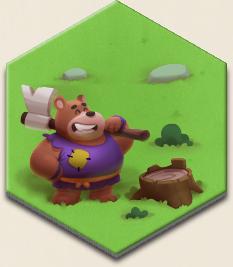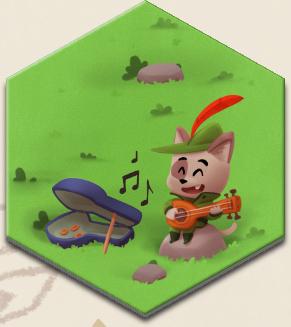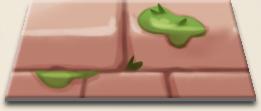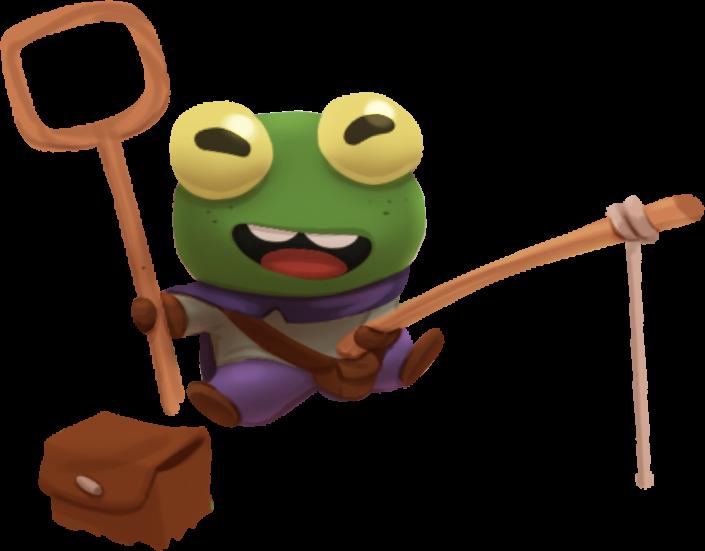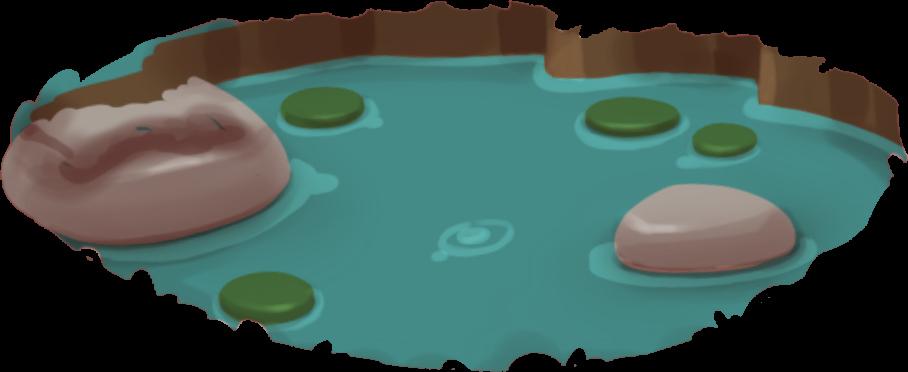















BIENVENIDOS
En Misty Valley, adoptaréis el rol de las tribus Buscarrastros y Roebayas para explorar un valle centenario, compitiendo por sus recursos y buscando alianzas con otros animales que lo habitan. Enviad las patrullas más convenientes y emplead vuestras habilidades especiales para controlar las losetas. Al final de la partida, éstas os otorgarán puntos de victoria. Quien consiga más puntos ganará. ¡Que empiece la aventura!
COMPONENTES Y PREPARACION DE PARTIDA
2 Tableros de tribu
La persona más joven elige un tablero de tribu y lo pone delante de ella del lado que quiera. Su rival hace lo mismo con el restante.
10 Marcadores de habilidad
Buscad los marcadores correspondientes a vuestro tablero de tribu y colocadlos sobre él en los espacios apropiados.
21 Fichas de estandarte
Coged 10 fichas de estandarte y colocadlas por la cara de vuestra tribu encima de vuestro tablero (la ficha sobrante es de repuesto, devolvedla a la caja).
18 Losetas de patrullas
Coged las 9 losetas de patrulla de vuestra facción, mezcladlas boca abajo y formad una pila delante de vosotros. Robad 3 losetas de vuestra pila sin revelarlas al rival para formar vuestra mano inicial.
8 Losetas de encuentros
Mezcladlas y formad una pila boca abajo a un lado de la mesa.
1 Loseta inicial
Poned la loseta inicial en el centro de la mesa.
2 Capitanes de tribu
Colocad ambos capitanes de tribu sobre la loseta inicial.
15 Losetas de valle
Mezclad boca abajo todas las losetas de valle y devolved al azar dos de ellas, sin revelar, a la caja. Formad una pila boca abajo con las losetas restantes y colocadlas a un lado de la mesa. Acontinuación, revelad 2 de ellas y colocadlas junto a la loseta inicial, en lados opuestos. Si aparecen huellas en alguna, revelad de la pila de encuentros una loseta y colocadla adyacentemente a ésta y a la inicial. Por último, revelad dos losetas más y dejadlas junto a la pila.
14 Fichas de expansion
Ponedlas boca abajo al lado de la pila de valle si incluís la expansión “muros y flores”(ver última página). Si no, dejadlas en la caja.
Ya lo tenéis todo listo para jugar. ¡La persona más joven empieza!







OBJETIVO DEL JUEGO
En Misty Valley, el objetivo es conseguir más puntos que tu rival, controlando el mayor número de losetas de valle y las losetas de encuentro más convenientes. Cuantas más losetas controles de un mismo tipo de recurso, más puntos obtendrás. Controlando losetas de encuentro y cumpliendo sus requisitos, obtendrás puntos extra. ¡Adelante!
COMO JUGAR
En tu turno, elige una de éstas dos acciones principales:
Explorar:
• Escoge una de las dos losetas de valle que están al descubierto o la que está en la cima de la pila sin revelar.
• Colócala adyacente a otra loseta ya en juego, con uno al menos uno de sus lados en pleno contacto.
• Si la loseta elegida tiene huellas en ella, revela la loseta superior de la pila de encuentros y colócala junto a ésta con uno de sus lados en pleno contacto.


• Si tomaste una loseta ya visible, reemplázala revelando la siguiente de la pila.
Enviar patrullas:
• Sitúa una de tus tres losetas de patrulla en el tablero, rotándola como prefieras, con uno de sus lados en pleno contacto con cualquier otra.
• Luego, roba una nueva loseta de tu pila para tener tres en mano.
No se puede colocar una loseta en un espacio completamente rodeado de otras losetas; debe existir un acceso a ella.
Nota: Las losetas de patrulla tienen diversos propósitos: pueden conquistar otras losetas, reforzar el control sobre alguna, abrir espacio para futuras losetas o bloquear patrullas del rival.







CONTROLANDO LOSETAS
Al añadir una loseta junto a otra, verifica cuántos exploradores de cada tribu están en contacto con los lados de las losetas de valle o de encuentro adyacentes. La tribu con más exploradores alrededor toma el control, colocando su estandarte sobre la loseta, para indicar que ahora está en su poder. Si ya hubiera un estandarte de la facción contraria, éste se girará al lado de la facción dominante. En caso de empate en el número de exploradores, el control no cambia. Se necesita un mínimo de 1 explorador adyacente a una loseta para controlarla. Si una loseta no tiene exploradores a su alrededor, no puede haber ningún estandarte; de igual modo, si en algún momento se retiraran o anularan todos los exploradores, el estandarte se retira.
Marta (facción azul) juega la acción “Enviar patrullas” y coloca una de sus losetas al lado de las losetas de cristales y setas. Al superar el número de patrullas rivales que rodean la loseta de cristales (2 contra 1), obtiene su control y gira el estandarte a su color. También coloca otro estandarte de su color en la loseta adyacente de setas (1). El control de la loseta de bellotas no cambia, ya que hay empate (1 contra 1).


TIPOS DE LOSETAS
Losetas de valle:
Hay 5 variantes, con 3 copias de cada: bellotas, setas, cristales, bayas y agua (recordad que 2 se devolvieron al inicio).
Losetas de encuentro:
Representan habitantes que os piden recursos para aliarse contigo. Se controlan siguiendo las mismas reglas que las losetas de valle. Al final, otorgan más puntos si controlas la loseta de valle junto con los recursos requeridos (ver "Final y puntuación").


El gato trovador solicita bellota y controlar otra loseta de encuentro al final de la partida.



ACCIONES ESPECIALES
En tu turno, antes o después de tu acción principal, puedes realizar una de estas dos acciones especiales:
Mover a tu capitan
Puedes mover a tu capitán a una loseta de valle o de encuentro que se encuentre bajo tu control. La presencia del capitán en la loseta suma +1 al número de exploradores que tienes controlando esa loseta. Si tu rival te arrebatara el control de la loseta o ésta se moviera, el capitán regresa a la loseta inicial.
Usar una habilidad especial
Elige una habilidad y ejecuta su efecto colocando el marcador en la loseta afectada o girándolo según indique la habilidad. Cada habilidad sólo puede usarse una vez por partida. Una habilidad no puede mover una loseta que esté totalmente rodeada por otras losetas, ni en ningún caso se puede dejar una o más losetas separadas del conjunto.
Después de que hayas realizado una acción principal y, opcionalmente una acción especial, el turno pasa a tu rival.
Nota: Si es vuestra primera partida o queréis jugar una partida más fácil, podéis jugar prescindiendo de estas acciones y dejando los tableros de tribu, fichas de habilidad y capitanes en la caja.
Linus (facción roja), antes de su acción pricipal, usa la habilidad especial “Contraorden”, que le permite mover a cualquier lugar su loseta de patrulla colocada anteriormente. Al hacerlo, reevalúa la loseta de cristales “abandonada”, que en este caso no sufre ninguna modificación. También comprueba las losetas a las que llega (gato trovador y loseta de agua) y pasan a su control al obtener la mayoría en ambas, colocando un estandarte en ellas.
















HABILIDADES ESPECIALES
Contraorden
Mueve una de tus losetas de patrulla ya jugadas a otra posición. Después reevalúa el control de las losetas adyacentes y con las que estaba en contacto previamente. Dale la vuelta al marcador de habilidad.
Despistar
Rota una loseta de patrulla rival un lado hacia la derecha o hacia la izquierda. Reevalúa el control de las losetas adyacentes y dale la vuelta al marcador de habilidad.
Bomba de humo
Coloca el marcador cubriendo uno de los lados de cualquier loseta de patrulla rival. Todos los exploradores de ese lado quedarán anulados. Reevalúa el control en las losetas adyacentes.
Refuerzos
Coloca el marcador en la loseta de patrulla jugada en este mismo turno, apuntando a un lado que tenga uno o más exploradores. Este marcador añade dos exploradores extra a ese lado. Luego reevalúa el control en las losetas adyacentes.
Catalejo
Juega una loseta extra de valle o de encuentro. Dale la vuelta al marcador de habilidad.
Diplomacia
Intercambia uno de tus estandartes de una loseta bajo tu control con un estandarte rival en cualquier otra loseta. (ambas losetas pueden volver a cambiar de controlador de forma normal al añadir una loseta de patrulla adyacentemente). Dale la vuelta al marcador de habilidad.
Cuerno de llamada
Juega una loseta de patrulla de tu mano. Roba una nueva loseta y dale la vuelta al marcador de habilidad.
Pergamino magico
Mueve cualquier loseta de valle o encuentro hasta otra posición. Después reevalúa su control y dale la vuelta al marcador de habilidad.



FINAL DE LA PARTIDA Y PUNTUACION
Cuando una de las dos facciones coloca la última loseta de valle, se activa el final de la partida: su rival tiene un último turno en el que podrá jugar la acción “Enviar exploradores”, pero no podrá usar ninguna habilidad. La partida se acaba después de este último turno. Acontinuación, poned frente a vosotros las losetas que controláis y contad los puntos:
• 1 loseta de valle vale 2 puntos.
• 2 losetas de valle del mismo recurso, 6 puntos.
• 3 losetas de valle del mismo recurso, 12 puntos.
• 1losetadeencuentrode1requerimiento cumplido, 5puntos.
• 1losetadeencuentrode2requerimientos cumplidos,7puntos.
En caso de no cumplir con todos los requerimientos de una loseta, ésta vale 2 puntos (una misma loseta de valle puede usarse para cumplir el requisito de varias losetas de encuentro). Además, obtienes 2 puntos por cada habilidad sin usar. La tribu con la mayor puntuación gana la partida. En caso de empate, gana quien tenga más losetas de patrulla en su mano. Si persiste el empate, jugad otra partida.
Recuerda: si usas todas tus losetas de patrulla y aún quedan losetas de valle , éstas deberán ser jugadas hasta agotarse y provocar el final de partida.








Marta puntúa 1 loseta de setas (2 puntos), 2 losetas de bellotas (6 puntos) y 3 losetas de bayas (12 puntos). También ha conseguido la loseta de encuentro del ratón con una bellota como requisito. Como posee al menos 1 loseta de bellota, la loseta de encuentro pasa a valer 5 puntos. El oso (que requiere agua y bayas) tan sólo le hace ganar 2 puntos, ya que controla losetas de bayas, pero no de agua. Conserva una habilidad sin usar que le otorga 2 puntos más, por lo que suma un total de 29 puntos.



EXPANSION: MUROS Y FLORES
Cuando tengáis dominado el juego, incluid la expansión “Muros y flores”. En la preparación, mezclad las fichas y ponedlas en una pila boca abajo al lado de la pila de losetas de valle. Siempre que un jugador ponga una loseta de valle en juego, revela una ficha de evento y la coloca encima de la loseta jugada. La forma de colocarla depende del tipo de ficha:
Ficha de muro
Colocadla encima de la loseta en uno de sus lados libres (No puede haber una loseta adyacente en el lado elegido). El muro bloquea a los exploradores que se coloquen adyacentes a él y no contarán para evaluar el control de loseta.
Ficha de flores
Simplemente colocad la ficha en la loseta. Al final de la partida, el jugador que controle un mayor número de losetas de valle con flores en ellas ganará 5 puntos extra.


Una ficha permanecerá sobre la loseta hasta el final de la partida incluso aunque ésta se vea afectada por una habilidad especial.
CREDITOS
Diseño de juego: Óscar Romero • Ilustraciones: Samuel Suarez
Desarrollo de juego, diseño grafico y edición: Sergi Marcet
Agradecimientos del autor:
ASilvia, a Sergi Marcet por su amistad, su gran implicación y confianza en el proyecto, a Xavier Moratonas de Lu2, a laAsociación Ludo, al Burning Proto, R. Knizia y a todas las personas que han probado el juego y que disfrutan jugando.
Agradecimientos del editor:
Atodas las personas que me han apoyado a lo largo de estos años; mi familia y amigos.Al círculo Burning Proto, Óscar y Samuel por creer en proyecto, Marta Lluch, Toni Oltra, Jofre Belles, Sergio Hernández, Pierre Rivoire y aAlberto Cano, sin el que este juego no hubiera sido posible.
Un agradecimiento especial a nuestros mecenas:
Abel Molero, Adrià Marcet, Adrián, Adrián Lop, Agustín F. Marín, Albamgarces, Àngels Puigcerver, Alejandra Tassis, Albert i Ona, Alexmoreg, Álvaro Blázquez, Andoni, Ana María Casanova, Arnau Bellés, Artur Pañach, Beeboop, Cay Garrido, Chavi1978, Cheyenne, Chompy A Tua Mia, Clara Rojas, Comte Estruc, César Hermosín, Cristina Fuentes, Inma Gallardo, Dani Desastre, David Arnaiz, David Heras, David Octane, David Esteve, Diegorookie, EcoMimos, Edurne Ciriaco, Elena Magán, Elena Martínez, elbauldeeva@hotmail.com, Elena2088, Enric Sintes, Enrique Alvo, Erika y Darío Sánchez, Es Tu Turno, Eva Haro, Eva Serrat, FPrivas, Fábio Lima, Gallipato, Gabriel Santasmarinas, Gemma Vidal, Generación Hortaleza, Guillermo Longhini, Honolulu, Invedars, Isaac Hidalgo, Ismaelyl@gmail.com, Javier Carballeda, Javi Dogo, Javi B.M., Jesús Martínez, Jessica, Jofre Bellés, Jokin García, Jonathan González, Jonatan Rey, Jordi Sánchez, Jprl9, Joaquín López, Juan García, Juan José Mateos Vivas, Juan Pardo, Juanma Muraday, Keichan Manuel Martínez, Kings, Kordoch, Kolondro, Kothoga, LaGatera, Laura Dalmau, Latroupedemonike, Ludo_looser, Lurdst, Magia de Tinta, Manuel Vega, Mapacheencelo, Marc De Mena, María Rovira, Markus, Matías Soria, Mau, Nachete VB Gamer, Nando Caravaca, Nico Cardona, Noemí Lapresta, Óliver Rivero, Oscaresasi, Oscoba, Òscar Garcia, Paolo, Perepau Listosella, Pol Giménez, Quico33, Raulcd, Reivaj, Ricardo Carretero, Ric LZ, Rocket Lemon Games, Rosa Ruiz, Rmr_ stma, Sergimarfe, Sergio Gómez, Sergio Fernández , Silvia, Tatiana Buen, Tania Baranda, Tekieiya, Toni López, Toni Oltra, Antoni Rovira, Toto, Triforce13, UnasMazmorritas, Vicente Martínez, Wolfito, Xtreme, Xenescal, Ydus, Txykytxyky, 4cubitos.




WELCOME
In Misty Valley, you will take on the role of the Trailseekers tribe and the Berrygnawers tribe to explore a centuries-old valley, competing for its resources and seeking alliances with other animals that inhabit it. Send out the most suitable patrols and use your special abilities to gain control of the tiles. At the end of the game, these will grant you victory points. The player with the most points wins. Let the adventure begin!
COMPONENTS AND GAME SETUP
2 Tribe boards
The youngest player chooses a tribe board and places it in front of them on the side they prefer. Their opponent does the same with the remaining board.
10 Skill Markers
Find the markers corresponding to your tribe board and place them on it in the appropriate spaces.
21 Banner Tokens
Take 10 banner tokens and place them banner-side-up on top of your board (the extra token is a spare, return it to the box).
18 Patrol Tiles
Take the 9 patrol tiles of your faction, shuffle them face down, and form a stack in front of you. Draw 3 tiles from your stack without revealing them to your opponent to form your initial hand.
8 Encounter Tiles
Shuffle them and form a face-down stack on one side of the table.
1 Starting Tile
Place the starting tile in the center of the table.
2 Tribe Captains
Place both tribe captains on the starting tile.
15 Valley Tiles
Shuffle all the valley tiles face down and randomly return two of them, without revealing them, to the box. Form a face-down stack with the remaining tiles and place them on one side of the table. Then, reveal 2 of them and place them next to the starting tile, on opposite sides. If footprints appear on any of them, reveal an encounter tile from the encounter pile and place it adjacent to it and the starting tile. Finally, reveal two more tiles and leave them next to the pile.
14 Expansion tiles
Place them face down next to the valley pile if you include the "Walls and flowers" expansion (see the last page). If not, leave them in the box.
Everything is now ready to play. The youngest player starts!







GAME OBJECTIVE
In Misty Valley, the goal is to score more points than your rival by controlling the most valley tiles and the most advantageous encounter tiles. The more tiles you control of the same resource type, the more points you'll earn. By controlling encounter tiles and fulfilling their requirements, you'll earn extra points. Go for it!
HOW TO PLAY
On your turn, choose one of these two main actions:
Explore:
• Choose one of the two exposed valley tiles or the one on top of the unrevealed pile.
• Place it adjacent to another tile already in play, with at least one of its sides in full contact.
• If the chosen tile has footprints on it, reveal the top tile from the encounter pile and place it next to it with one of its sides in full contact.
• If you took a visible tile, replace it by revealing the next tile from the pile.
Send Patrols:

• Place one of your three patrol tiles on the board, rotating it as you prefer, with one of its sides in full contact with any other tile.
• Then, draw a new tile from your stack to always have three in hand. A tile cannot be placed in a space completely surrounded by other tiles; there must be access to it.
Note: Patrol tiles have various purposes: they can conquer other tiles, reinforce control over some, create space for future tiles, or block rival patrols.







CONTROLLING TILES
When adding a tile next to another, check how many explorers from each tribe are in contact with the sides of the adjacent valley or encounter tiles. The tribe with the most explorers around takes control, placing their banner on the tile to indicate it is now in their power. If there was already an opponent's banner, it is flipped to the side of the new dominant faction. In case of a tie in the number of explorers, control does not change. A minimum of 1 explorer adjacent to a tile is needed to control it. If a tile has no explorers around it, no banner can be present; likewise, if at any point all explorers are removed or neutralized, the banner is removed.
Example: Marta (blue faction) plays the "Send Patrols" action and places one of her tiles next to the crystal and mushroom tiles. By outnumbering the rival patrols surrounding the crystal tile (2 against 1), she takes control and flips the banner to her color. She also places another of her banners on the adjacent mushroom tile (1). The control of the acorn tile does not change, as there is a tie (1 against 1).

TYPES OF TILES
Valley Tiles:
There are 5 variants, with 3 copies of each: acorns, mushrooms, crystals, berries, and water (remember that 2 were returned at the beginning to the box). You cannot place a tile in a space that is completely surrounded; there must be access to it.
Encounter Tiles:
These represent inhabitants asking for resources to ally with you. They are controlled following the same rules as valley tiles. In the end, they award more points if you control the valley tile along with the required resources (see "End and Scoring").


The Troubadour Cat requests an acorn and control of another encounter tile at the end of the game.



SPECIAL ACTIONS
On your turn, before or after your main action, you can perform one of these two special actions:
Move Your Captain
You can move your captain to a valley or encounter tile under your control. The presence of the captain on the tile adds +1 to the number of explorers you have controlling that tile. If your opponent takes control of the tile or if the tile is moved, the captain returns to the original tile.
Use a Special Ability
Choose an ability and execute its effect by placing the marker on the affected tile or rotating it as indicated by the ability. Each ability can only be used once per game. An ability cannot move a tile that is completely surrounded by other tiles, nor can you leave one or more tiles separated from the group.
After you have performed a main action and, optionally, a special action, the turn passes to your opponent.
Note: If it is your first game or you want to play a lighter game, you can play without these actions and leave the tribe boards, ability tokens, and captains in the box.
Example: Linus (red faction), before his main action, uses the special ability "Counterorder," which allows him to move any of his previously placed patrol tiles to any location. By doing so, he checks the "abandoned" crystal tile, which in this case undergoes no change. He also checks the tiles he reaches (Troubadour Cat and water tile) and takes control of them by gaining the majority on both, placing a banner on them.















SPECIAL ABILITIES
Counterorder:
Move one of your already played patrol tiles to another position. Then reevaluate the control of the adjacent tiles and the ones it was previously in contact with. Flip the ability marker over.
Mislead
Rotate an opponent's patrol tile one side to the right or left. Then reevaluate the control of the adjacent tiles and flip the ability marker over.
Smoke Bomb
Place the marker covering one of the sides of any opponent's patrol tile. All explorers on that side will be nullified. Reevaluate control on adjacent tiles.
Reinforcements
Place the marker on the patrol tile played in the same turn, pointing to a side that has one or more explorers. This marker adds two extra explorers to that side. Then reevaluate control on adjacent tiles.
Spyglass
Play an extra valley or encounter tile. Flip the ability marker over.
Diplomacy
Swap one of your banners from a tile under your control with an opponent's banner on any other tile. (both tiles can change controllers normally by adding an adjacent patrol tile). Flip the ability marker over.
Horn of Calling
Play a patrol tile from your hand. Draw a new tile from your stack and flip the ability marker over.
Magic Scroll
Move any valley or encounter tile to another position. Then reevaluate its control and flip the ability marker over.



END OF THE GAME AND SCORING
When one of the two factions places the last valley tile, the end of the game is triggered: their opponent has one last turn in which they can play the "Send Explorers" action, but they cannot use any abilities. The game ends after this last turn. Next, lay out the tiles you control in front of you and count the points:
• 1 valley tile is worth 2 points.
• 2 valley tiles of the same resource, 6 points.
• 3 valley tiles of the same resource, 12 points.
• 1encountertilewith1requirement met,5points.
• 1encountertilewith2requirements met,7points.
If not all requirements of a tile are met, it’s worth 2 points (the same valley tile can be used to meet the requirement of several encounter tiles). Additionally, you get 2 points for each unused ability. The tribe with the highest score wins the game. In case of a tie, the winner is the one with the most patrol tiles in their hand. If the tie persists, play another game.
Remember: if you use all your patrol tiles and there are still valley tiles available, these must be played until they are exhausted and trigger the end of the game.








Marta scores 1 mushroom tile (2 points), 2 acorn tiles (6 points), and 3 berry tiles (12 points). She also achieved the encounter tile of the mouse with an acorn as a requirement. As she owns at least 1 acorn tile, the encounter tile is worth 5 points. The bear (which requires water and berries) only earns her 2 points, as she controls berry tiles, but not water tiles. She keeps one unused ability which gives her 2 more points, making her total 29 points.



EXPANSION: WALLS AND FLOWERS
When you have mastered the game, include the "Walls and Flowers" expansion. During setup, mix the tokens and place them in a pile face down next to the pile of valley tiles. Whenever a player plays a valley tile , reveals an event token and places it on top of the played tile. The way to place it depends on the type of token:
Wall Token
Place it on one of the free sides of the tile (There cannot be an adjacent tile on the chosen side). The wall blocks the explorers placed adjacent to it and they will not count when evaluating tile control.
Flower Token
Simply place the token on the tile. At the end of the game, the player who controls the most valley tiles with flowers on them will gain an extra 5 points.


A token will remain on the tile until the end of the game even if it is affected by a special ability.
CREDITS
Game Design: Óscar Romero • Art: Samuel Suarez Game Development, Graphic Design, and Editing: Sergi Marcet
Author's Acknowledgments:
To Silvia, to Sergi Marcet for their friendship, their great involvement and trust in the project, to Xavier Moratonas from Lu2, to the LudoAssociation, the Burning Proto, R. Knizia, and to all the people who have tested the game and enjoy playing it.
Editor's Acknowledgments:
To all the people who have supported me throughout these years; my family and friends. To the Burning Proto group, Óscar and Samuel for believing in the project, Marta Lluch, Toni Oltra, Jofre Belles, Sergio Hernández, Pierre Rivoire, and toAlberto Cano, without whom this game would not have been possible.
A special thanks to all of our backers:
Abel Molero, Adrià Marcet, Adrián, Adrián Lop, Agustín F. Marín, Albamgarces, Àngels Puigcerver, Alejandra Tassis, Albert i Ona, Alexmoreg, Álvaro Blázquez, Andoni, Ana María Casanova, Arnau Bellés, Artur Pañach, Beeboop, Cay Garrido, Chavi1978, Cheyenne, Chompy A Tua Mia, Clara Rojas, Comte Estruc, César Hermosín, Cristina Fuentes, Inma Gallardo, Dani Desastre, David Arnaiz, David Heras, David Octane, David Esteve, Diegorookie, EcoMimos, Edurne Ciriaco, Elena Magán, Elena Martínez, elbauldeeva@hotmail.com, Elena2088, Enric Sintes, Enrique Alvo, Erika y Darío Sánchez, Es Tu Turno, Eva Haro, Eva Serrat, FPrivas, Fábio Lima, Gallipato, Gabriel Santasmarinas, Gemma Vidal, Generación Hortaleza, Guillermo Longhini, Honolulu, Invedars, Isaac Hidalgo, Ismaelyl@gmail.com, Javier Carballeda, Javi Dogo, Javi B.M., Jesús Martínez, Jessica, Jofre Bellés, Jokin García, Jonathan González, Jonatan Rey, Jordi Sánchez, Jprl9, Joaquín López, Juan García, Juan José Mateos Vivas, Juan Pardo, Juanma Muraday, Keichan Manuel Martínez, Kings, Kordoch, Kolondro, Kothoga, LaGatera, Laura Dalmau, Latroupedemonike, Ludo_looser, Lurdst, Magia de Tinta, Manuel Vega, Mapacheencelo, Marc De Mena, María Rovira, Markus, Matías Soria, Mau, Nachete VB Gamer, Nando Caravaca, Nico Cardona, Noemí Lapresta, Óliver Rivero, Oscaresasi, Oscoba, Òscar Garcia, Paolo, Perepau Listosella, Pol Giménez, Quico33, Raulcd, Reivaj, Ricardo Carretero, Ric LZ, Rocket Lemon Games, Rosa Ruiz, Rmr_ stma, Sergi Martín, Sergio Gómez, Sergio Fernández , Silvia, Tatiana Buen, Tania Baranda, Tekieiya, Toni López, Toni Oltra, Antoni Rovira, Toto, Triforce13, UnasMazmorritas, Vicente Martínez, Wolfito, Xtreme, Xenescal, Ydus, Txykytxyky, 4cubitos.




BIENVENUE
Dans Misty valley, vous incarnerez la tribu Chaspistes et la tribu Mordibaies pour explorer une vallée centenaire, en compétition pour ses ressources et cherchant des alliances avec les autres animaux qui l’habitent. Envoyez vos patrouilles de manière judicieuse et utilisez vos compétences spéciales pour prendre le contrôle des tuiles représentant cette vallée et ses habitants. A la fin de la partie, ces dernières vous rapporteront des points de victoire. Celui qui en aura acquis le plus sera le vainqueur. Que l’aventure commence !
MATERIEL ET MISE EN PLACE DE LA PARTIE
2 Plateaux de tribu
Le plus jeune joueur choisit un plateau de tribu et le place devant lui du côté qu’il préfère. Son rival fait de même avec celui qui reste.
10 Jetons de competence
Cherchez les jetons visibles sur votre plateau de tribu et placez-les sur les zones correspondantes.
21 Jetons etendards
Prenez chacun 10 jetons étendards et placez-les, côté de votre tribu visible, sur votre plateau (le jeton restant est une pièce de rechange et ne servira pas pour la partie).
18 Tuiles de patrouille
Prenez les 9 tuiles de patrouille de votre tribu, faces cachées, et mélangez-les pour former une pioche devant vous. Piochez-en trois sans les montrer à votre rival pour former votre main de départ.
8 Tuiles de rencontre
Mélangez ces huit tuiles, faces cachées, pour créer une pioche commune accessible aux deux joueurs.
1 tuile de depart
Placez cette tuile au centre de la table.
2 Capitaines de tribu
Placez les deux capitaines de tribu sur la tuile de départ.
15 Tuiles de vallee
Mélanger, face cachée, toutes les tuiles de vallée et retirez-en deux de la partie sans les regarder. Formez une pioche avec les tuiles restantes et placez-la à un endroit accessible aux deux joueurs. Piochez ensuite les deux premières et placez les adjacentes à la tuile de départ sur des bords opposés de celle-ci. Si des empreintes sont présentes sur l’une d’entre elles, piochez une tuile de rencontre et placez-la de manière à ce qu’elle soit adjacente à la tuile possédant les empreintes et à la tuile de départ. Enfin, piochez deux autres tuiles et placez-les, faces visibles, près de la pioche.
14 Jetons d'extension
Placez-les faces cachées à côté de la pile de vallée si vous incluez l'extension "murs et fleurs" (voir la dernière page). Sinon, laissez-les dans la boîte.
Vous voilà prêts à commencer la partie.
Le plus jeune joueur commence la partie !







OBJECTIF DE LA PARTIE
Dans Misty Valley, l'objectif est d'obtenir plus de points que votre adversaire en contrôlant le plus grand nombre de tuiles de vallée et les tuiles de rencontre les plus appropriées. Plus vous contrôlerez de tuiles d'un même type de ressource, plus vous obtiendrez de points. En contrôlant des tuiles de rencontre et en remplissant leurs exigences, vous obtiendrez des points supplémentaires. En avant !
DEROULEMENT D’UN TOUR
Lors de votre tour, vous avez le choix entre deux actions principales :
Explorer:
• Choisissez l'une des deux tuiles de vallée visibles ou celle du sommet de la pile.
• Placez la tuile choisie adjacente à une autre tuile déjà en jeu, en alignant un bord de chacune de ces tuiles.
• Si la tuile choisie comporte des empreintes, révélez la tuile supérieure de la pile de rencontres et placez-la en contact avec l'un des côtés de la première tuile jouée.

• Si vous avez pris une tuile face visible, remplacez-la en révélant la suivante de la pile.
Envoyer une patrouille :
• Placez l'une de vos trois tuiles de patrouille sur le plateau, en la faisant pivoter comme vous le souhaitez, pour la mettre en contact avec n'importe quelle autre tuile.
• Ensuite, piochez une nouvelle tuile de votre pile pour toujours en avoir trois en main.
Une tuile ne peut pas être placée dans un espace entièrement entouré par d'autres tuiles ; il doit y avoir un accès à celle-ci.
Notes : Les tuiles de patrouille ont diverses utilisations : elles peuvent conquérir d'autres tuiles, renforcer le contrôle sur certaines, libérer de l'espace pour de futures tuiles ou bloquer les patrouille de l'adversaire.







CONTROLE DES TUILES
Lorsque vous ajoutez une tuile à côté d'une autre, vérifiez combien d'explorateurs de chaque tribu sont en contact avec les côtés des tuiles de vallée ou de rencontre adjacentes. La tribu ayant le plus d'explorateurs autour d’une tuile en prend le contrôle en plaçant son étendard sur cette tuile pour indiquer qu'elle est désormais sous son contrôle. Si un étendard de la faction opposée était déjà présent, il sera retourné du côté de la nouvelle faction dominante. En cas d'égalité, le contrôle ne change pas. Un minimum d'un explorateur adjacent à une tuile est nécessaire pour la contrôler. Si une tuile n'a aucun explorateur autour d'elle, aucun étendard ne peut être présent. De même, si à n’importe quel moment tous les explorateurs sont retirés ou annulés, l'étendard est également retiré.
Marta (faction bleue) joue l'action "Envoyer une patrouille" et place l'une de ses tuiles à côté des tuiles de cristaux et de champignons. En dépassant le nombre d’explorateurs ennemis entourant la tuile de cristaux (2 contre 1), elle en prend le contrôle et retourne l'étendard à sa couleur. Elle place également un autre étendard de sa couleur sur la tuile adjacente de champignons (1). Le contrôle de la tuile de glands ne change pas, car il y a une égalité (1 contre 1).

TYPES DE TUILES
Tuiles de vallee :
Il y a 5 variantes, avec 3 exemplaires de chaque : glands, champignons, cristaux, baies et eau (rappelez-vous que 2 ont été retireés du jeu au départ).
Tuiles de rencontre :
Elles représentent des habitants en quête de ressources pour s'allier à vous. Elles sont contrôlées en suivant les mêmes règles que les tuiles de vallée. À la fin de la partie, elles rapportent plus de points si vous contrôlez une tuile de vallée avec les ressources requises (voir FIN DE LA PARTIE ET SCORE).


Le chat ménestrel demande des glands et le contrôle d'une autre tuile de rencontre à la fin de la partie.







